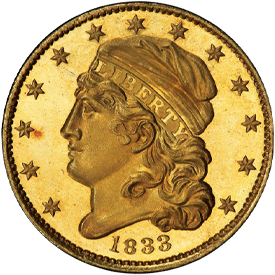Designed by: John Reich
Issue Dates: 1820-1821, 1825-1826, 1828-1834
Composition: 91.67% gold, 8.33% copper
Diameter: 25 mm (1813-1829), 22.5 mm (1829-1834)
Weight: 8.75 grams (135.03 grains)
Edge: Reeded
Proof Mintage: Fewer than 150
In 1813 the John Reich design was modified to a portrait featuring the head and part of the neck of Miss Liberty, facing right, an abbreviated version of the earlier style. In the new version, the stars completely surround the head, and the date is below. The reverse motif remains the same. From 1813 to 1829 half eagles were minted with a diameter of 25 mm. In 1829 the diameter was reduced to 22.5 mm and certain other modifications occurred, under the direction of William Kneass. Technically speaking, the 1829-1834 reduced diameter format can be considered a separate type, but as half eagles of this era are exceedingly rare, most numismatists have been content to consider the span 1813-1834 as a single design. The determination of what is a design type and what isn't is a matter of personal preference. There are many variables, such as the star count and position differences noted, for example, among half eagles of the 1795-1807 Heraldic Eagle reverse style.
Although mintages were fairly generous for many half eagles from 1813 through 1834, nearly all of the issues in this span are great rarities today due to extensive melting in the 1820s and 1830s when the bullion value of the coin exceeded its face value. The type set collector will have the best luck and the best use of his money if an issue such as 1813, 1814/3, 1818, or 1820 is selected, none of which will be inexpensive, but other issues are apt to be much more costly. The half eagle of the 1813-1834 design type is one of the highlights of a type set of early American gold coins.







